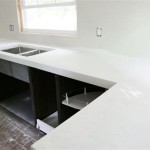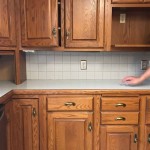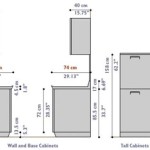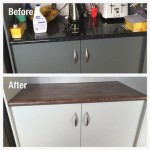How to Gel Stain Oak Cabinets: A Comprehensive Guide
Oak cabinets, prized for their durability and distinctive grain pattern, can become dated over time. Rather than replacing them entirely, gel staining offers a cost-effective and manageable solution to revitalize kitchen or bathroom spaces. This process involves applying a thick, gel-like stain that sits on the surface of the wood, minimizing the need for extensive sanding and providing a rich, even color. This article details the process of gel staining oak cabinets, from preparation to application, ensuring a successful and aesthetically pleasing result.
Key Point 1: Preparation – The Foundation for a Flawless Finish
Proper preparation is paramount to the success of any staining project, particularly when working with oak cabinets. This phase ensures the gel stain adheres correctly and provides a uniform color across the entire surface. Neglecting thorough preparation can lead to uneven staining, peeling, or other undesirable outcomes.
Step 1: Removal and Hardware Detachment
Begin by removing all cabinet doors and drawers from the frames. This allows for easier access and prevents stain from accumulating in hard-to-reach areas. Label each door and drawer with painter's tape indicating its original location to facilitate reinstallation. Remove all hardware, including knobs, pulls, hinges, and any decorative elements. Store these items in labeled bags to avoid confusion during reassembly.
Step 2: Cleaning and Degreasing
Oak cabinets, especially those in kitchens, often accumulate grease, grime, and cooking residue. These contaminants can interfere with stain adhesion. Thoroughly clean all surfaces with a degreasing cleaner specifically formulated for wood. Follow the manufacturer's instructions for dilution and application. Use a scrub brush or sponge to agitate the cleaner, paying close attention to corners, edges, and any areas with visible buildup. Rinse thoroughly with clean water and allow the cabinets to dry completely.
Step 3: Light Sanding and De-glossing
While gel stain minimizes the need for extensive sanding, a light sanding is essential to create a slightly roughened surface that promotes adhesion. Use a fine-grit sandpaper (220-grit or higher) to lightly sand all surfaces. The goal is not to remove the existing finish entirely, but rather to de-gloss the surface and provide "tooth" for the gel stain to grip. Focus on areas with a glossy finish or any imperfections. After sanding, remove all sanding dust with a tack cloth or vacuum with a brush attachment. A tack cloth is preferred as it effectively captures even the finest particles.
Step 4: Masking and Protection
Protect surrounding areas from potential stain splatters by applying painter's tape to adjacent walls, countertops, and flooring. Cover any surfaces that cannot be taped with drop cloths or plastic sheeting. This step minimizes cleanup and prevents accidental staining. Applying painter's tape carefully along the edges ensures a clean and professional-looking result.
Key Point 2: Gel Stain Application – Achieving an Even and Consistent Finish
The application of gel stain requires a specific technique to achieve an even and consistent finish. Unlike traditional stains that penetrate the wood, gel stain sits on the surface, making proper application crucial to avoid streaks, blotches, or uneven color distribution.
Step 1: Stirring the Gel Stain
Before beginning, stir the gel stain thoroughly with a stir stick. Gel stain tends to settle, and stirring ensures a consistent color throughout the application process. Avoid shaking the can, as this can create air bubbles that may show up in the final finish. Stir until the stain is evenly mixed and free of lumps.
Step 2: Applying the First Coat
Apply a thin, even coat of gel stain using a lint-free cloth, a foam brush, or a staining pad. Work in small sections and apply the stain in the direction of the wood grain. Avoid applying too much stain at once, as this can lead to drips and runs. Wipe off any excess stain immediately with a clean, lint-free cloth. The goal is to apply a thin, even layer of stain that covers the entire surface. Pay close attention to corners, edges, and details.
Step 3: Wiping and Refining
After applying the stain, use a clean, lint-free cloth to wipe off any excess. The amount of stain you wipe off will determine the final color intensity. Wiping more stain off will result in a lighter color, while wiping less stain off will result in a darker color. Be consistent with your wiping technique to ensure an even color across all surfaces. Pay attention to the wood grain and wipe in the direction of the grain to avoid leaving streaks.
Step 4: Drying Time
Allow the first coat of gel stain to dry completely according to the manufacturer's instructions. Drying times can vary depending on temperature and humidity. Typically, gel stain requires at least 24 hours to dry thoroughly. Avoid touching or handling the cabinets during the drying process. Ensure proper ventilation in the work area to facilitate drying. A slightly elevated temperature can help speed up the drying process.
Step 5: Applying Subsequent Coats (Optional)
If a darker or richer color is desired, apply a second coat of gel stain following the same procedure as the first coat. Lightly sand the surface with fine-grit sandpaper (320-grit or higher) between coats to ensure proper adhesion. Remove all sanding dust with a tack cloth before applying the second coat. Allow the second coat to dry completely before proceeding to the next step.
Key Point 3: Sealing and Protection – Enhancing Durability and Longevity
After the gel stain has dried completely, it is essential to apply a protective topcoat to seal the stain and protect the cabinets from wear and tear. A topcoat enhances the durability of the finish and provides resistance to scratches, stains, and moisture. Choosing the right topcoat is crucial to achieving the desired aesthetic and performance characteristics.
Step 1: Choosing a Topcoat
Several types of topcoats are suitable for use over gel stain, including polyurethane, varnish, and acrylic lacquers. Polyurethane is a popular choice for its durability and resistance to water and chemicals. Varnish provides a warm, amber tone and is often preferred for its traditional look. Acrylic lacquers offer excellent clarity and are a good option for maintaining the original color of the gel stain. Consider the desired appearance and the level of protection required when selecting a topcoat.
Step 2: Applying the Topcoat
Apply the topcoat using a brush, roller, or sprayer, following the manufacturer's instructions. Apply thin, even coats to avoid drips and runs. If using a brush, use a high-quality brush designed for the type of topcoat being used. If using a roller, use a foam roller to minimize brush strokes. If using a sprayer, ensure proper ventilation and wear appropriate safety gear. Work in a dust-free environment to prevent particles from becoming embedded in the finish.
Step 3: Sanding Between Coats (Optional)
For a smoother finish, lightly sand the surface with fine-grit sandpaper (320-grit or higher) between coats of topcoat. This process removes any imperfections and creates a smoother surface for the next coat to adhere to. Remove all sanding dust with a tack cloth before applying the next coat. This step is particularly important when using multiple coats of topcoat.
Step 4: Drying Time
Allow each coat of topcoat to dry completely according to the manufacturer's instructions. Drying times can vary depending on the type of topcoat and the environmental conditions. Ensure proper ventilation in the work area to facilitate drying. Avoid touching or handling the cabinets during the drying process. A slightly elevated temperature can help speed up the drying process.
Step 5: Reassembly
Once the final coat of topcoat has dried completely, reassemble the cabinets by reattaching the hardware and reinstalling the doors and drawers. Use the labels that were applied during the disassembly process to ensure that each door and drawer is returned to its original location. Tighten all screws securely. Inspect the finished cabinets for any imperfections or areas that require touch-up. Clean the cabinets with a mild soap and water solution.

How To Gel Stain Cabinets With Ease Diva Of Diy

How To Gel Stain Cabinets With Ease Diva Of Diy

How To Gel Stain Cabinets Printable She Buys He Builds

Pickled Oak Bathroom Vanity Transformation

Gel Stain Color Recommendations

How To Use Gel Stain On Cabinets The Good Bad

How To Gel Stain Your Cabinets On A Budget Budgeting For Bliss

Easy Gel Stain For Those Oak Cabinets 320 Sycamore

Stunning Transformation Staining Oak Cabinets

How To Stain Oak Cabinetry Tutorial The Kim Six Fix
Related Posts








